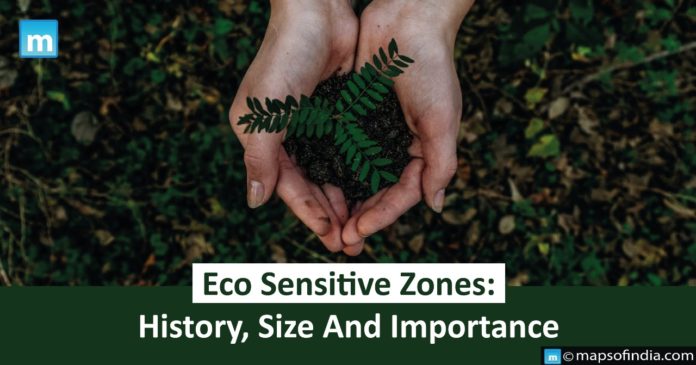Ecologically Fragile Area (EFA) is another Eco-Sensitive Zone (ESZ) name. The Ministry of Environment has designated ESZs surrounding Protected Areas such as Wildlife Sanctuaries and National Park. The goal of establishing ESZs is to establish “shock absorbers” for nature reserves by monitoring and supervising activities in and around these protected areas.
According to the National Board for Wildlife, the boundary of eco-sensitive zones must be site-specific, and efforts should be regulatory rather than prohibitive until necessary. This project’s overarching goal is to reduce the detrimental consequences of some operations near National Parks and Wildlife Sanctuaries to protect the fragile ecosystems surrounding these protected areas.
History of Eco-Sensitive Zones
- National Wildlife Action Plan (NWAP) 2002-2016 shows that the region outside conservation areas networks are crucial ecological corridor linkages that must be conserved to minimize the fragmentation of biodiversity pieces that will not persist in the long term.
- Section 3 of the Environment Protection Regulations empowers the Central Government, namely the Union Ministry of Environment and Forests, to take any steps it deems necessary to safeguard and preserve the quality of the environment, as well as to prevent and regulate environmental contamination.
- There is, however, no mention of the term “Eco-Sensitive Zone” in the 1986 Environment (Protection) Act.
- To achieve this goal, the government may limit the regions in which any industry, function, procedure, class of enterprises, or processes, may or may not be carried out, subject to specific protections.
- Nevertheless, Section 3(2)(v) of the Act states that the Central Government has the authority to limit the areas in which any industry, class of enterprises, operations, or processes, shall or shall not be carried out, subject to certain safeguards.
- As a result, the government devised the idea of Eco-Sensitive Zones.
- The government has declared No Development Zones using the same basis (NDZs).
Size of the Ecosensitive Zones
- According to the Wildlife Conservation Strategy, 2002, an ESZ might extend up to 10 kilometres surrounding a protected area.
- In the case of vulnerable corridors, accessibility, and biologically essential patches critical for landscape connection, regions wider than 10 km can be incorporated into the eco-sensitive area.
- Furthermore, even within the framework of a specific Protected Area, the distribution of an ESZ and the level of regulation may not be consistent throughout, and it may be of varied breadth and extent.
The Importance of Eco-Sensitive Zones
- Eco-sensitive zones would reduce the effect of industrialization and other development activities.
- The protected areas are managed using the core and buffer strategy, which also protects and benefits local populations.
- Eco-sensitive areas encircling protected areas, animal refuges, and national parks act as a ‘Shock Absorber.’
- An ESZ assists in in-situ conservation, which is concerned with protecting an endangered species in its natural environment, such as Kaziranga National Park in Assam, which protects one-horned rhinos.
- Eco-Sensitive Zones reduce deforestation and human-animal conflict.
Activities permitted In ESZs:
Activities Allowed in Eco-Sensitive Zones
These include ongoing agricultural or horticultural techniques, rainwater gathering, organic agriculture, renewable energy use, and green technologies for all activities.
Barred Activities:
Under Environmental Zones, it is prohibited to quarry, use wood commercially, run pollution-causing industries, conduct tourism around the National Park, release effluent, develop major hydropower projects (HEPs), or produce hazardous substances.
Monitored or regulated Activities
Felling of trees, creating of hotels and resorts, commercial exploitation of natural water, building power wires, drastic changes in farming systems, e.g. adoption of heavy technologies, pesticides, etc.




